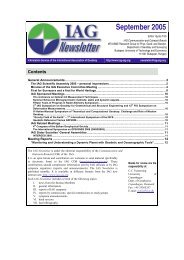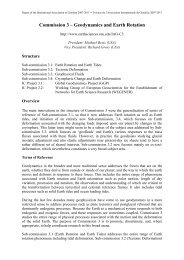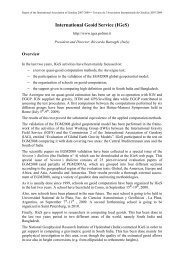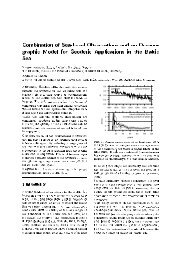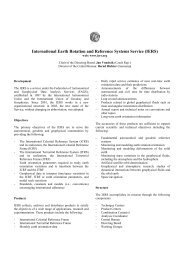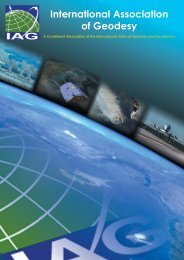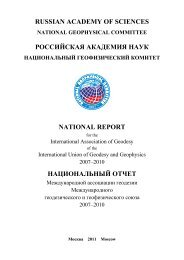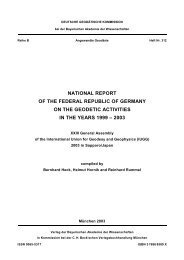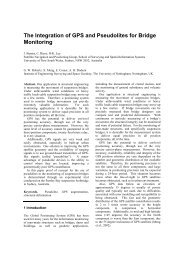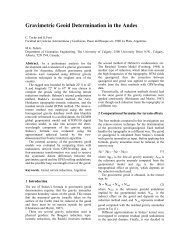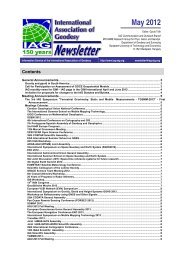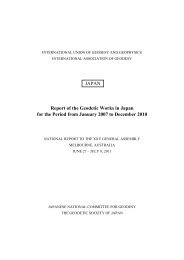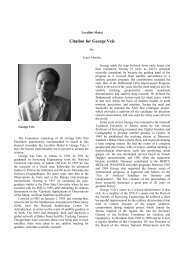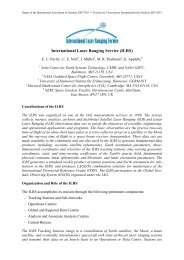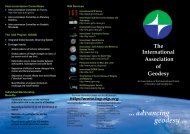Gravity Field - International Association of Geodesy
Gravity Field - International Association of Geodesy
Gravity Field - International Association of Geodesy
Create successful ePaper yourself
Turn your PDF publications into a flip-book with our unique Google optimized e-Paper software.
What is <strong>Geodesy</strong><br />
The Earth is not composed <strong>of</strong> solid rock, but<br />
due to the increase <strong>of</strong> temperature towards its<br />
centre it is built up from a mixture <strong>of</strong> viscous<br />
and solid materials. Thus the shape <strong>of</strong> the<br />
Earth is oblate, because the centrifugal force<br />
stemming from its rotational motion thrusts<br />
the masses out at the equatorial bulge.<br />
What about the hills, mountain ranges,<br />
and deep sea trenches<br />
These ‘topographic features’ are quite small<br />
compared to the size <strong>of</strong> our planet. Of course<br />
they are measured and drawn on maps, but<br />
in <strong>Geodesy</strong> their contribution to the shape <strong>of</strong><br />
the planet is quite small.<br />
These topographic features range from about<br />
9 km above sea level (Mount Everest) to<br />
approximately 12 km below sea level (Mariana<br />
Trench). The diameter <strong>of</strong> the Earth is roughly<br />
12756 km.<br />
However, as the accuracy <strong>of</strong> our observation<br />
techniques improves, the geodetic influence <strong>of</strong><br />
topographic features become more and more<br />
important. For example, the gravitational<br />
effects <strong>of</strong> the topographic masses are no longer<br />
negligible for geodetic investigations.<br />
Quite simply: <strong>Geodesy</strong> is the science<br />
concerned with the study <strong>of</strong> the shape, size<br />
and gravity field <strong>of</strong> the Earth.<br />
The Earth seems to be round, is it not<br />
In reality the Earth is not a perfect sphere.<br />
Knowledge <strong>of</strong> the exact shape <strong>of</strong> the Earth<br />
provides us with accurate maps <strong>of</strong> the Earth.<br />
During the evolution <strong>of</strong> geodetic science, it<br />
has been discovered that the shape <strong>of</strong> the Earth<br />
is not round, but it ‘bulges’ outward along the<br />
equator. Even this is an over simplification.<br />
The Earth has many ‘hills and troughs’ in the<br />
gravity potential field, indicating significant<br />
departures from symmetric mass distribution<br />
within the solid Earth. This is superimposed<br />
on the topographic variability we are all familiar<br />
with.<br />
Why do we need accurate maps<br />
Recall the old saying:<br />
Permanent GPS Station in southern Greenland,<br />
part <strong>of</strong> the GNET Project (Photo: M. Bevis)<br />
“You can not tell where you are going unless<br />
you know where you have been.”<br />
Maps play an important role in our lives.<br />
We need them to find our way in the world – to<br />
navigate. In ancient times mankind used<br />
landmarks to navigate their way to friends, to<br />
towns and ports, or other places <strong>of</strong> interest.<br />
Today we <strong>of</strong>ten use urban landmarks, such<br />
as shopping malls, churches, skyscrapers,<br />
road intersections, and other points <strong>of</strong> interest.<br />
But what happens, if we are not familiar with<br />
the town or rural area<br />
Then we need accurate maps to navigate,<br />
but also to indicate geometric relations<br />
between points or landmarks depicted on the<br />
map, to display information on areal extent <strong>of</strong><br />
different vegetation landuse, to design large<br />
infrastructure and transportation problems,<br />
and so on.<br />
In order to create accurate maps we need a<br />
well-defined spatial reference system. A spatial<br />
reference system defines the coordinate system<br />
and datum in which all landmarks have a<br />
unique “address” or position (i.e., coordinates).<br />
1



